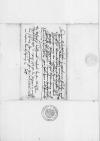Letter #5210
Ioannes DANTISCUS to Albrecht I von Hohenzollern-AnsbachHeilsberg (Lidzbark Warmiński), 1539-03-24
| received Königsberg (Królewiec), 1539-03-24 Manuscript sources:
Auxiliary sources:
Prints:
| ||||||||||
Text & apparatus & commentaryPlain textText & commentaryText & apparatus
 GStA PK, HBA, C1, No 558 2 unnumbered
GStA PK, HBA, C1, No 558 2 unnumbered
Dem durchlauchten, hochgebornen fursten und hern, hern
 GStA PK, HBA, C1, No 558 1 unnumbered
GStA PK, HBA, C1, No 558 1 unnumbered
Durchlauchter, hochgeborner furst, hochgunstiger, lyber herr und freundt. / Unser freuntliche, wÿllige dinst zuvoran. /
Uns hat der edel ernfester herr
Datum(m)
Ioannes, von Gots gnaden byschoff zu Ermelandt

